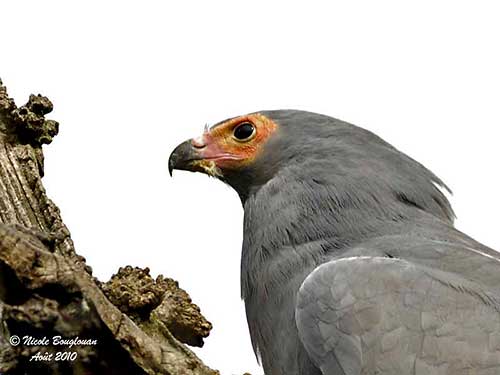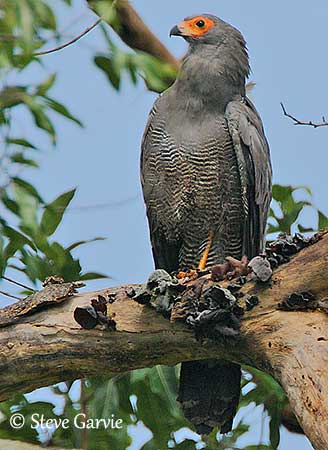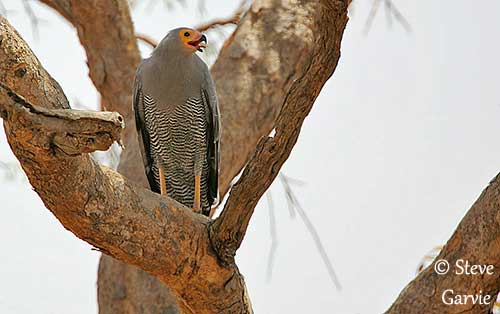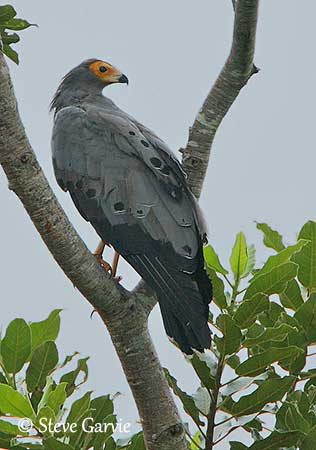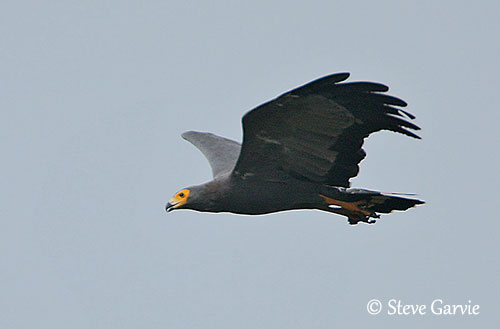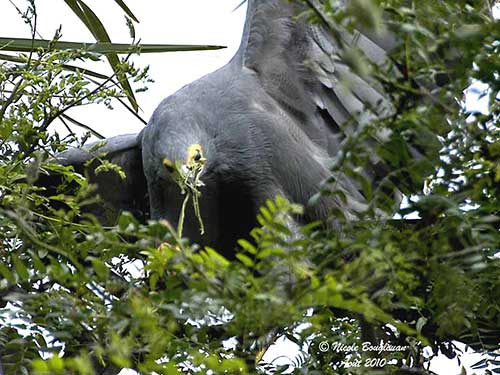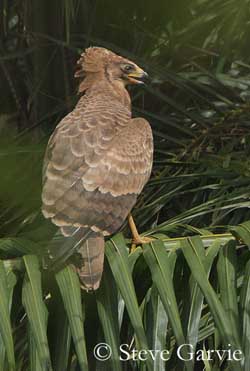
African Harrier Hawk (or Gymnogene or African Gymnogene)
Polyboroides typus
Accipitriforme Order – Accipitridae Family
BIOMETRICS:
Length: 60-66 cm; Wingspan: 160 cm ; Weight: 635-950 g
DESCRIPTION:
Gymnogene is a medium sized raptor. Upperparts, head and breast are pale grey. Belly is finely barred with black and white. It has broad pale grey wings, with edge fringed with narrow white line, and black spots on the wing coverts. A broad white band crosses the black tail.
Gymnogene has a bare facial patch, variable in colour, but often bright yellow. When it calls near the nest, this patch becomes pink, and during display, face becomes almost red, with various shades of orange between yellow and red.
Eyes are dark brown. Hooked short bill is black. Feet and legs are yellow, and double-jointed, with smallish feet.
Both sexes are similar.
HABITAT:
Gymnogene lives in woodland areas, forests, savannahs and cultivated areas, close to water, or in rainy areas, from sea level to 3000 metres elevation.
RANGE:
Gymnogene lives in Africa, South of Sahara. In southern Africa, it is locally common resident, but absent from the drier parts of the country.
BEHAVIOUR:
Gymnogene is usually solitary. It is specialized in robbing nests of holes nesting birds, with its adaptive flexible knee-joints to facilitate this habit. It can probes crevices and hollows for lizards and larvae, but when it robs weaver’s nests, it hangs upside-down to catch chicks and eggs.
To feed on oil palm nuts, it may walk along branches and foliages, feet over feet, using its wings to stabilize it.
Gymnogene hunts mainly in trees and bushes, but not on the wing. It performs hunting in weaver bird colonies to probe their nests.
It hunts by soaring, searching from a perch or walking on the ground, or over tree trunks, flapping loosely its wings. It invades waterbirds colonies to eat young and eggs, and may perform a low coursing flight across vegetation.
Its tarsal joint bends forwards, backwards and sideways, making it unique. Its small head allows it to extract some preys from crevices.
During courtship display, female flies turning on its back in order to present her talons to the male.
FLIGHT:
Gymnogene soars easily and steadily. In flight, it appears very buoyant, with its broad and rounded wings. Usually, it flies high over the forest, with a slow and buoyant flight.
REPRODUCTION:
Gymnogene breeds at the end of the dry season, from June to November. Its nest is located at the top of a tree, or in a rocky crevice near the ground.
The nest is a stick platform, with a rim of green fresh leaves, and lined with green sprigs.
Female lays 1 or 2 white eggs. Incubation lasts about 35 days, by both parents. Chicks are fed by both adults, mainly by female with food brought at nest by male. They fledge at about 45 to 55 days.
DIET:
Gymnogene feeds on chicks and eggs of small birds. But it also eats frogs, insects, small mammals and reptiles, and bats. Sometimes, when available, it may consume oil palm fruit.
PROTECTION / THREATS / STATUS:
Gymnogene is widely distributed in sub-Saharan Africa, except in the arid northern regions.
Fr: Gymnogène d’Afrique
All : Höhlenweihe
Esp: Aguilucho-caricalvo Común
Ital: Sparviero serpentario africano
Nd: Kaalkopkiekendief
Russe: Африканский луневый ястреб
Photographers:
Steve Garvie
RAINBIRDER Photo galleries
Nicole Bouglouan
PHOTOGRAPHIC RAMBLE
Text by Nicole Bouglouan
Sources:
HANDBOOK OF THE BIRDS OF THE WORLD Vol 2 by Josep del Hoyo-Andrew Elliot-Jordi Sargatal - Lynx Edicions - ISBN: 8487334156
BIRDS OF PREY OF AFRICA AND ITS ISLANDS by Alan and Meg Kemp - Struik Publishers - ISBN: 1770073698
BIRDS OF AFRICA SOUTH OF THE SAHARA by Ian Sinclair and Peter Ryan - Princeton University Press Princeton and Oxford - ISBN: 0691118159
The Hawk Conservancy Trust (Hilary Smith)
Wikipedia (Wikipedia, The Free Encyclopedia)

